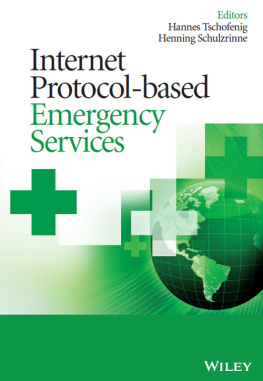For details of our global editorial offices, for customer services and for information about how to apply for permission to reuse the copyright material in this book please see our website at www.wiley.com .
The right of the author to be identified as the author of this work has been asserted in accordance with the Copyright, Designs and Patents Act 1988.
All rights reserved. No part of this publication may be reproduced, stored in a retrieval system, or transmitted, in any form or by any means, electronic, mechanical, photocopying, recording or otherwise, except as permitted by the UK Copyright, Designs and Patents Act 1988, without the prior permission of the publisher.
Wiley also publishes its books in a variety of electronic formats. Some content that appears in print may not be available in electronic books.
Designations used by companies to distinguish their products are often claimed as trademarks. All brand names and product names used in this book are trade names, service marks, trademarks or registered trademarks of their respective owners. The publisher is not associated with any product or vendor mentioned in this book.
Limit of Liability/Disclaimer of Warranty: While the publisher and author have used their best efforts in preparing this book, they make no representations or warranties with respect to the accuracy or completeness of the contents of this book and specifically disclaim any implied warranties of merchantability or fitness for a particular purpose. It is sold on the understanding that the publisher is not engaged in rendering professional services and neither the publisher nor the author shall be liable for damages arising herefrom. If professional advice or other expert assistance is required, the services of a competent professional should be sought.
Tschofenig, Hannes.
Internet protocol-based emergency services / Hannes Tschofenig.
pages cm
Includes bibliographical references and index.
ISBN 978-0-470-68976-9 (cloth)
1. Emergency communication systems. 2. Computer network protocols. 3. Internet. 4. Public safety
radio service. I. Title.
TK6570.P8S38 2014
004.678dc23
A catalogue record for this book is available from the British Library.
To my wife Verena and my daughter Elena. Verena encouraged
me to work on this project and motivated me when I got stuck
due to all my other obligations.
IETF 61 ECRIT BOF: Decision to form a Working Group
Communication architecture overview
Uncertainty
DHCPv6 GeoLoc option format
DHCPv4 GeoLoc option format
GeoRSS information model
LIS location types
DHCPv4 access domain name encoding for example.com
DHCPv6 Access domain name encoding for example.com
DNS LIS U-NAPTR example
Residential broadband network topology
HTTP location request
Location request with locationType
Location request using exact attribute
Location request using responseTime attribute
Location request using responseTime="emergencyRouting" attribute
Location response
Location URI set in location response
HELD error example
Device identity extensions structure
Complex device identity
A tel URI example
Location request with identity extension
Required identifiers example
HELD measurement container
Measurements in Location Request
HELD dereference context diagram
HELD policy URI request and response
Policy URI Usage
Device capabilities signaling diagram
Capability indication example
Capabilities agreement
Capability invoation
SET Initiated procedures for Proxy Mode and Non-Proxy Mode
IMS emergency services call flow
Network Initiated procedures for Proxy Mode
Network Initiated procedures for Non-Proxy Mode
Synchronous responses for Standard and Emergency Location Immediate Services
Asynchronous reporting for Standard and Emergency Location Immediate Services
Standard and Emergency Location Reporting Service
Subscription to Location Notifications
Location services architecture in 3GPP TM networks
Positioning network elements for UTRAN access networks
Positioning network elements for E-UTRAN access networks
The i2 functional architecture diagram
Basic call routing of VoIP emergency calls in NENA i2
Call routing using SIP Redirect Server in NENA i2
Call routing using an SIP Routing Proxy in NENA i2
High-level functionality of Location to Service Translation (LoST)
Main components involved in an emergency call
Trees and forest guides in the LoST mapping architecture
Example query/response in the LoST mapping architecture
Mapping element
Emergency services architecture with legacy endpoints
Business entities in WiMAX
Mobile WiMAX NRM
Network reference architecture for emergency services in WiMAX
Relations between stackholders in WiMAX emergency calls
Emergency network entry
WiMAX Location Support
Network-based location retrieval after handoff via anchor AAA client
User A calls User C while roaming to VPLMN B
CS emergency call while roaming to VPLMN
CS emergency call flow example
IMS: call between roaming subscribers
IMS emergency registration and call path
IMS emergency registration flow
IMS emergency call flow
SOS-NTP interconnection point to the PSAP
Generic emergency call flow
Routing overview
Residential user emergency call scenario
Emergency call scenario from a company running its own voice service
Emergency call scenarios for a multinational company running its own voice service
Example of PSTN breakout in Denmark, forwarding the emergency call over the PSTN to Sweden
Two emergency call scenarios for a telecommunication provider running a voice service for residential Users
Emergency call scenario where SIP trunk provider only forwards the call
Emergency call scenario where SIP trunk provider adds information
Todays emergency services architecture in the United Kingdom
Proposed UK VoIP transition emergency services architecture
Example VoIP Basic 9-1-1 interim solution
The Canadian i2 functional model
Schematic of the IN911 network topology
Communication model overview
Total Conversation relay support
Total Conversation concept: user interface example
All users in the chain have access to Total Conversation facilities
Functional blocks of the Monster IMS Client
Algorithm for placing incoming calls in the virtual queue
US DOT NG9-1-1 POC system architecture
SMS server
Screenshot of call-taker SIPc
Call origination networks
Basic emergency call flow













